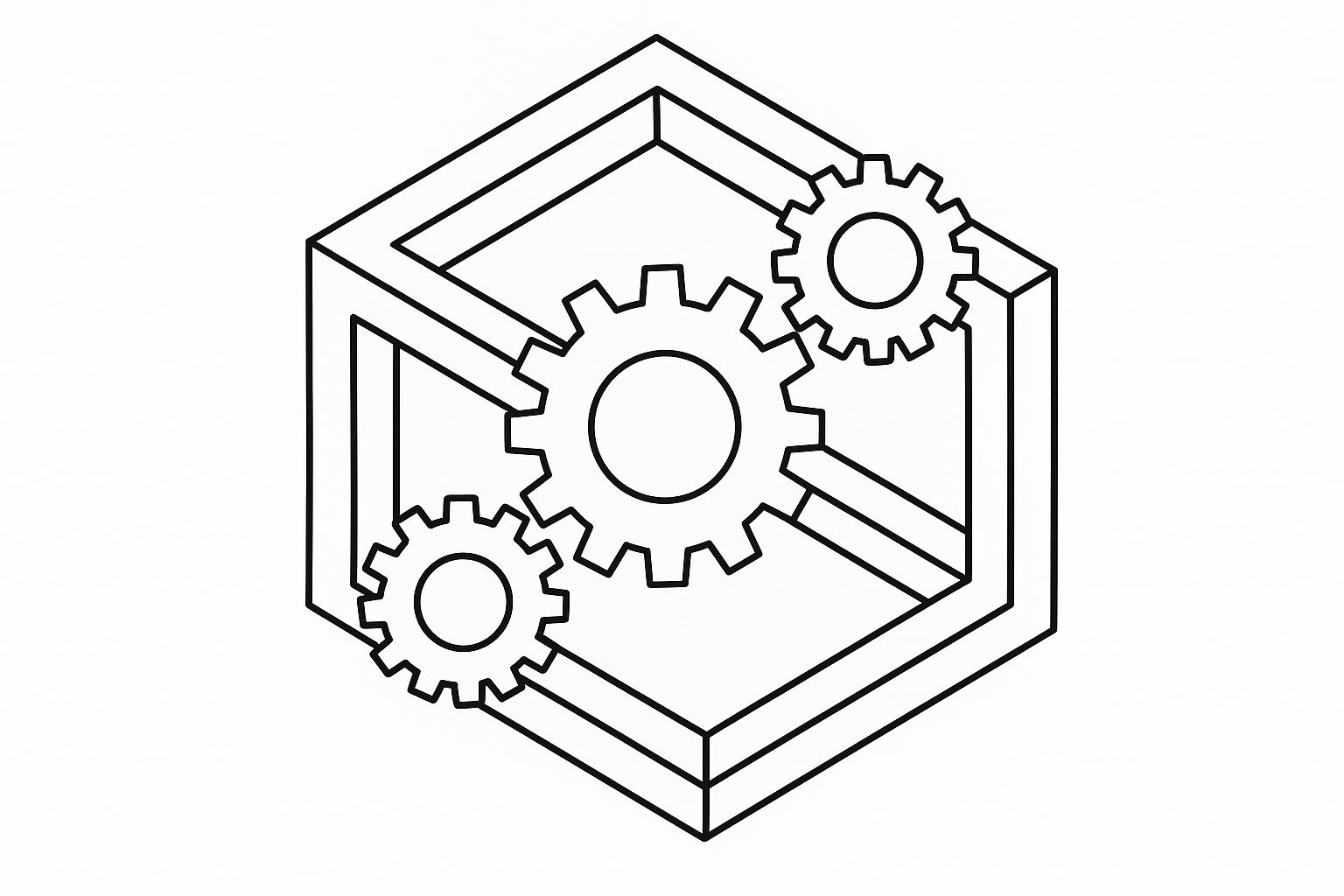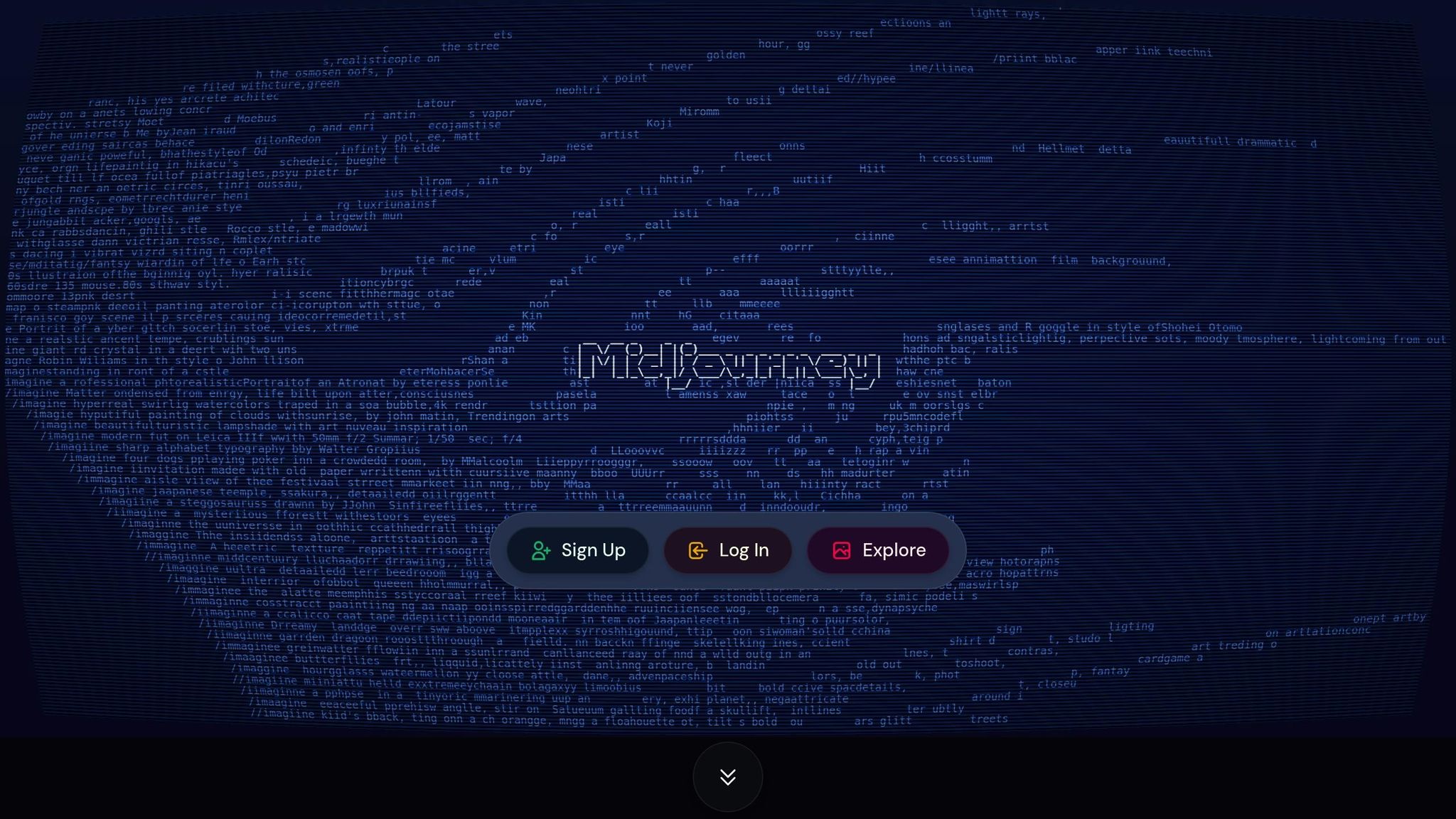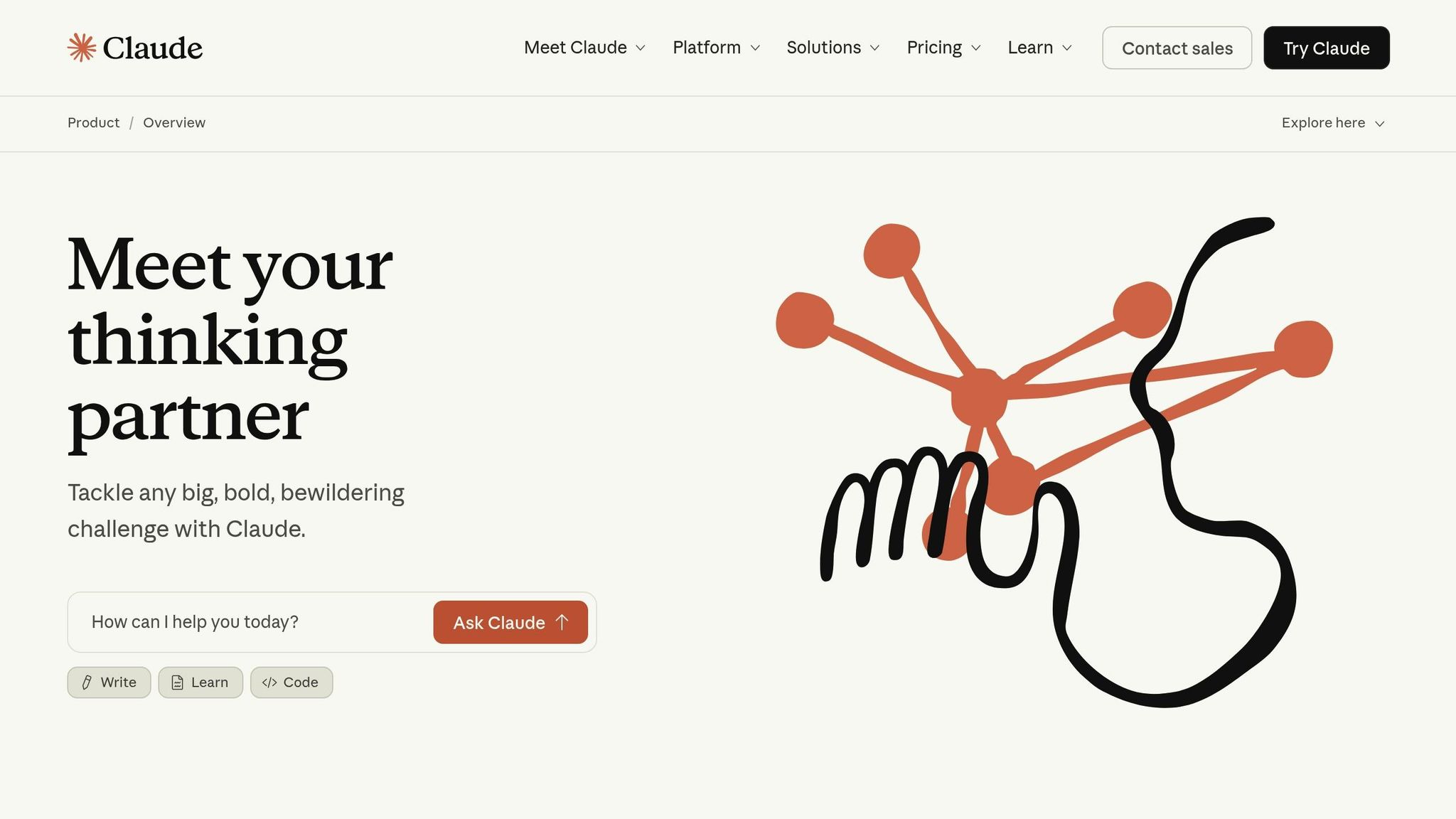
AI tools like ChatGPT, Midjourney, and Claude are transforming digital marketing by automating content creation, data analysis, and visual design. The key to leveraging these tools effectively? Writing precise prompts. Here’s what you need to know:

Team-GPT is a collaborative AI platform designed specifically for marketing teams, offering tools to create and share prompt libraries that streamline campaign development. With its prompt builder feature, marketers can fine-tune prompts to achieve optimal AI-generated content, ensuring messages resonate with a broad range of audiences. The platform also encourages collaboration, enabling team members to incorporate varied perspectives into AI-driven responses. Team-GPT provides a strong starting point with over 100 curated prompts and more than 50 tips and tricks for mastering ChatGPT.
"A shared prompt library and a simple workflow are usually enough to unlock speed." - INSIDEA
The platform includes pre-built prompts tailored to key marketing areas:
These resources enable teams to customize campaigns for various channels with ease.
Trusted by leading organizations like Maersk, EY, Charles Schwab, Johns Hopkins University, Yale University, and Columbia University, Team-GPT is accessible to businesses of all sizes, starting at $0 per user.
"Team-GPT is the best place to learn how to use ChatGPT properly: it's software designed to help you and your team adopt AI." - Iliya Valchanov, CEO, Team-GPT
The platform also allows users to select their preferred AI model, ensuring teams can take advantage of the latest advancements as AI technology and marketing strategies continue to evolve. These prompt libraries form the backbone of more advanced generative and analytics tools, creating an integrated AI-powered marketing ecosystem.
Up next, we’ll dive into generative text tools to further enhance your marketing capabilities.

ChatGPT has become a go-to tool for digital marketing teams, thanks to its ability to create a wide range of content - everything from emails and blog posts to social media updates. What makes it stand out is its knack for understanding context and keeping a consistent brand voice across different channels, making it a reliable choice for tailored content creation.
Whether it's crafting compelling product descriptions, writing engaging ad copy, or designing nurturing email sequences, ChatGPT simplifies the process. It handles diverse content needs with ease, all while staying true to the brand's tone and style.
Its performance improves significantly with well-thought-out prompts. Using structured prompt libraries, like God of Prompt's Complete AI Bundle, marketers can fine-tune ChatGPT's output for even more precise and impactful results. This approach supports strategies ranging from long-form content to platform-specific messaging.
For content marketing, ChatGPT can generate detailed articles, case studies, and white papers that help establish thought leadership. It can research topics efficiently and present them in an engaging way, allowing teams to maintain a steady flow of high-quality content without overextending their resources.
Social media managers also find ChatGPT invaluable. It adapts a single core message to fit the tone and style of different platforms - whether it’s LinkedIn’s professional vibe, Twitter’s snappy brevity, or Instagram’s visually driven focus. This adaptability saves time and ensures every platform gets optimized content while keeping the brand voice consistent across the board.
Another major advantage is how ChatGPT integrates into workflows to boost productivity. It can quickly generate A/B test variations for email subject lines or create multiple versions of ad copy for campaigns. Tasks that used to require manual effort are now streamlined, freeing up time for teams to focus on strategy and creativity.

Midjourney is changing the game for marketing teams by making it easier to create high-quality visuals using just text descriptions. Forget about needing advanced design skills or spending big on stock photo subscriptions - this tool lets you describe your ideas in plain English and delivers multiple image variations in return. It’s a huge time-saver, especially when testing different visuals for A/B campaigns, and allows for more precise adjustments through refined prompts.
One of Midjourney's standout features is its ability to maintain a brand’s visual identity. By including detailed prompts with specifics like brand colors, preferred styles, and the desired mood, teams can generate visuals that align perfectly with their overall branding. Whether it’s product mockups, lifestyle shots, or abstract imagery for thought leadership pieces, the tool’s results improve significantly when prompts include details like artistic style, lighting, composition, and key brand elements.
The platform also excels at producing visuals optimized for different platforms and audiences. This is especially helpful for smaller teams or agencies that need a variety of visuals but don’t have the budget or resources for a full-time design team. Instead of outsourcing graphics or relying on generic stock images, Midjourney enables teams to create custom visuals that align perfectly with their campaign goals and brand identity.
Once the visuals are generated, they can seamlessly fit into existing workflows. Teams can use prompt templates and approval processes to streamline the integration. Plus, there’s the option to refine these AI-generated images further with traditional design tools, blending the speed of AI with the creativity of human designers for polished, professional results.

Claude acts as a helpful partner for analyzing data, making it easier for teams to understand complex information without needing deep technical skills. Unlike traditional analytics platforms that often require specialized training, Claude uses conversational prompts. This means marketers can ask questions in plain English and get tailored, easy-to-understand insights in return.
By pulling information from various sources - like campaign metrics and customer feedback - Claude identifies patterns, correlations, and opportunities that might otherwise go unnoticed. It’s particularly useful for uncovering how different marketing channels work together, showing how each touchpoint contributes to your campaign’s overall performance.
What sets Claude apart is its ability to provide context alongside actionable recommendations. Instead of just presenting numbers, it explains what the data means for your business goals and suggests practical next steps. For instance, when analyzing email campaigns, Claude can highlight which subject lines resonate most with your audience and recommend adjustments to improve engagement.
Claude also simplifies reporting by creating concise executive summaries and translating complex findings into clear, digestible insights for stakeholders. This reduces the back-and-forth between marketing teams and data analysts, enabling quicker decisions and more flexible campaign tweaks. Teams can even create reusable prompt templates for regular analysis, ensuring consistent and efficient reporting while staying adaptable to market changes.
For those looking to make the most of Claude, God of Prompt offers a curated collection of prompts and guides. These resources help marketing teams maximize the insights they can draw from their data, setting the stage for seamless integration and comparison of analytics across AI tools in the following section.
After exploring individual AI tools, the next step is weaving them into a cohesive marketing ecosystem. By integrating tools like ChatGPT, Claude, and Midjourney, marketing teams can amplify their campaigns and create a seamless workflow where each tool complements the others.
One crucial step is establishing consistent prompt templates to maintain your brand voice across platforms. Research indicates that 55% of marketing professionals heavily rely on AI for text-based content creation. However, 31% of marketers note that AI-generated outputs sometimes fall short, highlighting the importance of crafting high-quality prompts and ensuring human oversight. A unified approach - rooted in prompt libraries and the combination of text and visual tools - can ensure campaigns are cohesive and effective.
Experimentation and providing detailed context are also key strategies, with 55% and 53% of marketers, respectively, reporting better outcomes when these methods are applied. Teams that excel often develop a shared prompt playbook. This playbook includes templates tailored for various use cases, along with specific details like context requirements, tone guidelines, output formats, and examples of successful results. Such resources streamline the integration of AI tools and create a more efficient workflow.
To turn this integration into measurable results, align AI usage with your marketing objectives and KPIs. Start by identifying areas where AI can save time by taking over repetitive tasks. Then, embed these AI-driven processes into your existing workflows and tools.
At scale, it’s essential to enforce standards like fact-checking, brand voice consistency, bias detection, and privacy compliance. These guardrails ensure your AI ecosystem operates at a high level of professionalism while delivering the efficiency your team needs.
For teams aiming to simplify this process, resources like God of Prompt offer curated prompt collections and guides tailored for marketing workflows. These tools help create consistent templates across platforms, fostering an integrated system where every AI tool strengthens the overall strategy.
The digital marketing world is changing rapidly, and advanced AI prompt tools are leading the charge. Teams that use these tools wisely are seeing boosts in both creativity and productivity. As AI becomes a key player in content creation, marketers who excel in prompt engineering are unlocking its full potential.
Success in this space isn’t about adopting every flashy tool. It’s about building a cohesive system. By combining tools like ChatGPT or Claude for text generation, Midjourney for visuals, and analytics platforms, marketing teams can create a seamless AI-powered ecosystem. This approach transforms scattered tools into a unified, efficient marketing engine.
But let’s not forget the essentials: experimentation and context. The best teams don’t just dabble - they create detailed prompt playbooks, ensure their brand voice stays consistent across all platforms, and set up quality control to maintain high standards.
The payoff goes beyond saving time. Teams are finding new levels of creativity, delivering more personalized customer experiences, and scaling their content production without losing quality. Achieving this, however, requires constant learning and refining of prompts.
For teams ready to take the leap, platforms like God of Prompt provide a valuable starting point. With over 30,000 curated prompts tailored to business, marketing, SEO, and productivity, it removes the trial-and-error guesswork from prompt engineering. Its categorized bundles and regular updates ensure users stay ahead in the ever-evolving AI landscape.
The future belongs to marketing teams that see AI not as a replacement for human creativity, but as a tool to amplify it. With well-crafted prompts, efficiency improves, and creative possibilities expand. Your journey with AI starts with that first carefully designed prompt - make it count.
Marketing teams can craft powerful prompt libraries by developing well-structured, reusable templates tailored to specific tasks such as content creation, SEO, or email marketing. Organizing these prompts into clear categories makes them easy to locate and apply whenever needed.
To ensure prompts stay effective, it's important to regularly update and tweak them based on performance metrics and campaign outcomes. Leveraging centralized tools like shared folders or collaboration platforms (e.g., Google Docs or Notion) ensures that everyone on the team has access to the most up-to-date versions. This method not only simplifies workflows but also enhances content quality and strengthens team collaboration.
To produce AI-generated visuals that truly reflect your brand's style and campaign objectives, start with well-thought-out, detailed prompts. Be sure to specify elements like your brand's color scheme, preferred design features, tone, and any other visual guidelines that define your identity. Including examples of your current brand assets can also guide the AI in capturing your aesthetic more accurately.
After generating the visuals, go through an iterative review process. Fine-tune the results by adjusting the prompts or making manual edits to ensure the visuals align with your campaign goals and brand consistency. Working closely with your design team to apply final touches can elevate the quality and ensure everything fits seamlessly with your brand image.
Integrating AI tools such as ChatGPT, Midjourney, and Claude can transform how marketing teams operate. These tools take on repetitive tasks, speed up content creation, and make it easier to deliver personalized messages at scale. With their help, teams can quickly produce a variety of marketing materials, tweak strategies using real-time data, and test fresh ideas without the usual bottlenecks.
When these AI tools are combined into a cohesive system, they can simplify workflows, improve team collaboration, and free up time for more impactful creative projects. The result? Better outcomes and more efficient use of resources.





